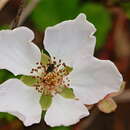Comprehensive Description
provided by North American Flora
Rubus trivialis Michx. Fl. Bor. Am. 1: 296. 1803
Rubus hispidus Marsh. Arbust. 137. 1785. Not R. hispidus h. 1753. ? Rubus nitidus Raf. Fl. Ludov. 98. 1817.
Stems biennial, prostrate and trailing, 5-20 dm. long, slender, terete, more or less hispid and with small, slightly flattened prickles; leaves of the turions 3-5-foliolate, persistent; stipules linear-subulate, deciduous; petioles, petiolules, and sometimes midveins more or less armed with recurved prickles; petioles 2-5 cm. long; leaflets glabrous, subcoriaceous, ovate or oblanceolate, sharply serrate, with ovate cuspidate teeth directed forward, acute at the apex, rounded or obtuse at the base, 2-6 cm. long, dark-green and shining above, paler and duller beneath, the median one with a petiolule 3-15 mm. long, the lateral ones of the 5-foliolate leaves with petiolules 2-10 mm. long, the outermost short-petioluled or subsessile; leaves of the erect floral branches 3-foliolate; leaflets smaller, 1-4 cm. long, more elliptic or oval, rounded or obtuse at the apex, and with shorter and broader teeth; flowers terminal, mostly solitary; peduncles 2-5 cm. long, more or less tomentulose and prickly, elliptic or oval, 5-6 mm. long, mucronate or short-acuminate, tomentulose within; petals white, obovate, 10-15 mm. long; fruit usually oblong, 1—1.5 cm. long, black; drupelets many, large, glabrous.
Type locality: Carolina.
Distribution: Dry fields, from Virginia to Florida, Texas, and Oklahoma^
- bibliographic citation
- Per Axel Rydberg. 1913. ROSACEAE (pars). North American flora. vol 22(5). New York Botanical Garden, New York, NY
Comprehensive Description
provided by North American Flora
Rubus trivialis Michx. Fl. Bor. Am. 1: 296. 1803
Rubus hispidus Marsh. Arbust. 137. 1785. Not R. hispidus L. 1753. ? Rubus nitidus Raf. Fl. Ludov. 98. 1817.
Stems biennial, prostrate and trailing, 5-20 dm. long, slender, terete, more or less hispid and with small, slightly flattened prickles; leaves of the turions 3-5-foliolate, persistent; stipules linear-subulate, deciduous; petioles, petiolules, and sometimes midveins more or less armed with recurved prickles; petioles 2-5 cm. long; leaflets glabrous, subcoriaceous, ovate or oblanceolate, sharply serrate, with ovate cuspidate teeth directed forward, acute at the apex, rounded or obtuse at the base, 2-6 cm. long, dark-green and shining above, paler and duller beneath, the median one with a petiolule 3-15 mm. long, the lateral ones of the 5-foliolate leaves with petiolules 2-10 mm. long, the outermost short-petioluled or subsessile; leaves of the erect floral branches 3-foliolate; leaflets smaller, 1-4 cm. long, more elliptic or oval, rounded or obtuse at the apex, and with shorter and broader teeth; flowers terminal, mostly solitary; peduncles 2-5 cm. long, more or less tomentulose and prickly, elliptic or oval, 5-6 mm. long, mucronate or short-acuminate, tomentulose within; petals white, obovate, 10-15 mm. long; fruit usually oblong, 1-1.5 cm. long, black; drupelets many, large, glabrous.
Type locality : Carolina. -«,.,>•« , ™ t *.
Distribution: Dry fields, from Virginia to Florida, Texas, and Oklahoma^
- bibliographic citation
- Per Axel Rydberg. 1913. ROSACEAE (pars). North American flora. vol 22(5). New York Botanical Garden, New York, NY
Comprehensive Description
provided by North American Flora
Rubus rubrisetus Rydb. in Britton, Man. 497. 1901
Stems biennial, trailing, 2-4 m. long, weakly prickly and densely glandular-hispid with red or purplish bristles; leaves of the turions 5-foliolate, thick and evergreen; petioles, petiolules, and midveins hispid and with a few prickles; petioles 4-5 cm. long; leaflets all petioluled, oval, obovate, or lance-ovate, glabrous, except the veins beneath, dark-green and shining above, duller beneath, irregularly serrate, with ovate, acuminate teeth, 3-5 cm. long, acute or shortacuminate at the apex, acute at the base; petiolules of the inner three leaflets about 1 cm. long, those of the outer leaflets half as long or shorter; floral branches 1-1.5 dm. long, hispid; leaves 3-5-foliolate; leaflets 2-3 cm. long, more obtuse and with shorter petiolules; flowers 3-7, in small terminal corymbs, usually somewhat leafy-bracted below; peduncles and pedicels glandular-bristly and sometimes with small prickles; sepals ovate, short-acuminate, with subulate tips, tomentulose on both sides; petals white, oval, about 1 cm. long.
Type locality: New Orleans, Louisiana.
Distribution: Mississippi Valley, from Missouri to Louisiana.
- bibliographic citation
- Per Axel Rydberg. 1913. ROSACEAE (pars). North American flora. vol 22(5). New York Botanical Garden, New York, NY
Rubus trivialis
provided by wikipedia EN
Rubus trivialis, commonly known as southern dewberry, is a species of flowering plant in the rose family (Rosaceae) native to the southern United States and northern Mexico.[1] It is distinguished from northern dewberry (Rubus flagellaris) by its hispid stems.[2] It is a perennial herb and blooms March to April.[3]
References

- license
- cc-by-sa-3.0
- copyright
- Wikipedia authors and editors
Rubus trivialis: Brief Summary
provided by wikipedia EN
Rubus trivialis, commonly known as southern dewberry, is a species of flowering plant in the rose family (Rosaceae) native to the southern United States and northern Mexico. It is distinguished from northern dewberry (Rubus flagellaris) by its hispid stems. It is a perennial herb and blooms March to April.
- license
- cc-by-sa-3.0
- copyright
- Wikipedia authors and editors

